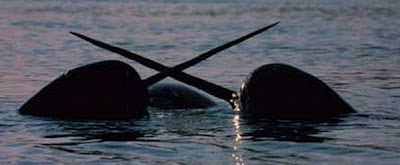The Narwhal - that unicorn of the Arctic seas - what's with the tusk?
Joshua Jones of the Scripps Institution of Oceanography describes the narwhal's tusk as the end result of one tooth which is actually part of a second set of teeth the narwhal has deep below the skin. The tooth works its way through bone and skin and can reach a length of up to 9 feet. While typically found in the male, females have been known to have them and, on rare occasions, some males have grown double tusks (see picture, right).
But why the tusk in the first place?
There's no definitive answer but the most common theory is that of social interaction. Male narwhals have been seen "crossing swords" in narwhal breeding grounds, perhaps to establish a pecking order. In these clashes, sometimes the tusk can be broken off, kind of a cetacean version of getting your teeth knocked out. Researchers have seen tusk-less narwhals still fit and healthy which is an indicator that the tusk may not be used as a hunting weapon, like a sawfish's toothy proboscis.
One of nature's truly unique creations, the narwhal's population is relatively stable with polar bears, orcas, and limited hunting by Inuits as their only threats. But climate change can pose a serious risk as the narwhal is confined to the Arctic by a narrow temperature range within which it survives. Rising water temperatures can shrink their available habitat and put these remarkable whales at risk.









No comments:
Post a Comment